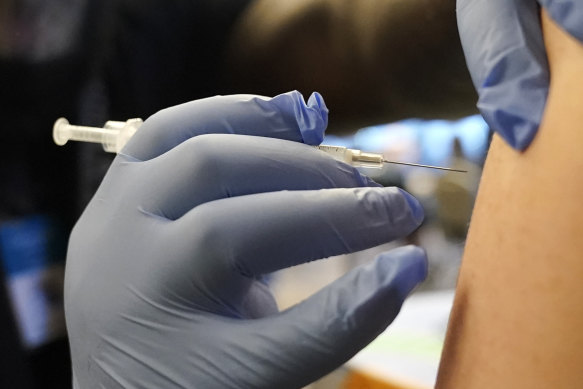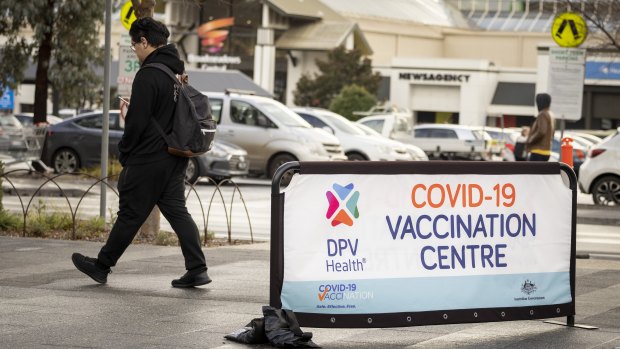This was published 1 year ago
Opinion
COVID debate is masking the best line of defence
Julie Leask
Professor at the University of SydneySo much of the heat over how we manage the current COVID-19 wave is about mandatory masks, yet Australia has dropped the ball where it matters most right now – booster vaccination.
Australia led the world in two-dose uptake, reaching 96 per cent of people aged over 16 years. But we have stalled on boosters, where rates have sat about 70 per cent for weeks. For NDIS participants, 76 per cent have had a booster; for First Nations people, it’s just 54 per cent.

The number of Australians receiving booster shots has stalled. Credit: AP
We need to focus our attention on boosters. They sit at the top of a limited set of COVID-19 management tools. A booster markedly reduces a person’s risk of severe disease if they have it three months after a previous vaccine or infection. A study of more than 2 million Sydney residents during the first Omicron wave estimated that one hospitalisation or death was prevented for every 192 people aged over 70 getting a third dose. In an Israeli study, a fourth dose lowered the rate of severe disease by a factor of three.
Your postcode should not determine your likelihood of having a vaccine that could greatly reduce your risk of hospitalisation from COVID. Yet, that is what is occurring. Some of this will be explained by people’s recent infections delaying their booster. But the huge differences in geographic vaccination rates tell a familiar story of inequity.
Local council areas of Queensland and western Sydney dominate the lowest-ranked booster rates. Just 49 per cent of people in Queensland’s Central Highlands have had three or more doses. In Cumberland, western Sydney – which includes Greystanes, Merrylands, Guildford, Granville and Auburn – it’s 55 per cent. Contrast that with wealthy Mosman in Sydney at 83 per cent. This drops even more for First Nations individuals – in one very remote community in Queensland, only 31 per cent are boosted.

The take-up of booster vaccinations has been poorest in areas that most need the protection.Credit: Wayne Taylor
It is easy to get outraged about so-called “anti-vaxxer” hotspots when such areas have the lowest vaccination rates. But we need to pay attention to the areas where people face disadvantage, and not with outrage or stigmatisation, but with listening and constructive solutions.
As a resident of western Sydney for two decades, I know there are many communities with different reasons for not vaccinating.
Social research, backed up by conversations I’ve had with people in my local community, reveals an information gap on vaccination. There is a lack of clear, translated, actionable information about why boosters are needed now. We learn how misinformation fills voids created when accurate information flows too slowly. We learn of the challenges in getting transport to the clinic and other practical barriers that remain for some.
Earlier this year, fatigued service providers with burnt-out workforces switched to recovering other neglected areas of public health. Health departments shrunk vaccination budgets and teams, reducing the availability of mobile services to reach people and engage with community leaders.
Vaccination needs to get back on the agenda. We need to inform strategies with data, starting with separating the figures on third and fourth doses down to small area levels. When it was revealed that Blacktown had low coverage compared with other areas, local leaders wanted to solve the problem. A more comprehensive breakdown also makes local governments and community health managers more accountable. Governments should also make the findings of social data public so that communities can use the information.
Social norms strongly influence vaccination. A message to vaccinate coming from somebody we trust and respect can be much more powerful than one from government. We need to work with community leaders, first listening to the issues, then in campaign planning, pre-testing and supporting them to be local advocates. The Collaboration on Social Science in Immunisation has helped many groups with workshops that inform them about COVID-19 vaccines and train them for positive conversations.
Needing a focus on vaccine boosters is not to say masks are not important – they are. High rates of community mask-wearing are estimated to reduce transmission of COVID-19 by about 10 percentage points, according to infectious diseases epidemiologists who study their impacts.
Masks pull our focus as highly visible expressions of protection, altruism and solidarity. Mandates can be effective if they are enforced, but the fines disproportionately affect poorer suburbs; they are saddling children with debt and fomenting mistrust in public health more generally.
COVID is not going away. We need to find more sustainable ways to ensure people continue to wear masks when needed. Governments urge us to take “personal responsibility” as if this is the only other option, but this is a false dichotomy. Between mandates and personal responsibility lie many things that governments can do.
Behaviour change and maintenance is at the heart of managing COVID-19. Taking boosters, wearing masks, staying at home with any symptoms, testing, making an antiviral plan, opening windows and hand-washing – these are all behaviours. Alongside the epidemiology, we need the behavioural and social sciences. And we need to keep speaking with communities.
Julie Leask is a behavioural scientist at the University of Sydney who specialises in vaccination.
Liam Mannix’s Examine newsletter explains and analyses science with a rigorous focus on the evidence. Sign up to get it each week.